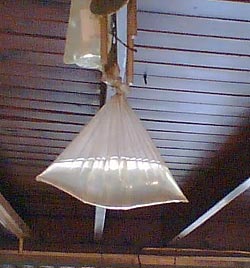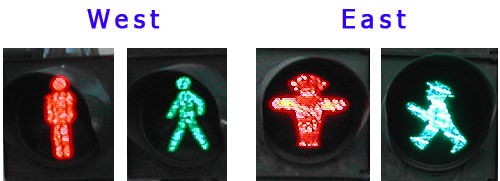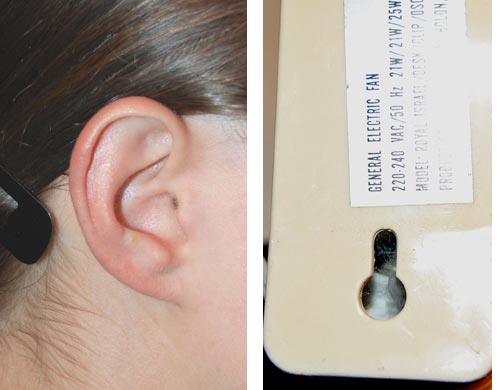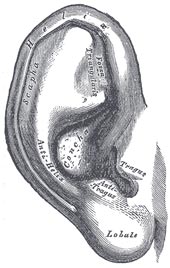We all know about vestigial organs in living creatures, such as the useless vermiform appendix that gives many people a bad time. These were useful in earlier releases of our body plan, but are now just along for the ride.
So here is a sighting of a similarly useless historical remnant in a Bosch power drill.

I refer to the rubber part affixed to the power cord near the drill’s grip. This well-designed part was very handy in the drills of our youth…
 The intent was to keep the chuck key from getting lost, of course… you could stick it into the hole and the rubber flaps would keep it in place when it wasn’t being used to tighten the chuck. These keys were all too easy to misplace, so this was an excellent solution – as the vermiform appendix used to be when we were all eating leaves before we became humans and learned about chocolate and other delights.
The intent was to keep the chuck key from getting lost, of course… you could stick it into the hole and the rubber flaps would keep it in place when it wasn’t being used to tighten the chuck. These keys were all too easy to misplace, so this was an excellent solution – as the vermiform appendix used to be when we were all eating leaves before we became humans and learned about chocolate and other delights.
The thing is, my drill came with the now common keyless chuck… so the key holder is totally unnecessary. At least it isn’t prone to inflammation…
Anyone interested in the Brain – that ultimate piece of high technology – has seen the true but overused statement that each age in history sees the brain as analogous to the latest current technology: the ancients thought of it as a hydraulic system, our grandparents as a telephone exchange, our parents as a computer…
Well, I’ve just run into the next step in this progression. We were watching House on TV, and the irritating genius explained to a colleague that the brain is like the internet, where information packets flow this way and that.
I’m not sure at all that this is a good description – in fact I doubt it very much – but at any rate, we’re one step beyond the brain-as-computer now. Can’t help but wonder what the brain will be likened to next?…
Recently Elite, a major manufacturer of chocolate, candy and coffee in Israel, launched a campaign to prepare us all for “the same beloved familiar taste in a new packaging”. Every instant coffee can had a sticker heralding the change, then the new cans came out with stickers extolling it.
 Now actually, the change is minimal and mostly unimportant, as you can see in the photo of the old can (at left) and the new. They have a slightly modified graphic design, but it’s the same good ol’ coffee we’re all addicted to. But there is one change that caught my eye: the new can is noticeably taller. Since both contain 200g of the same powder, you’d think it was also thinner; and in a sense it is, but not at the base; in fact the bottom and top are of identical diameter. The new can, however, has a “waist” in the middle.
Now actually, the change is minimal and mostly unimportant, as you can see in the photo of the old can (at left) and the new. They have a slightly modified graphic design, but it’s the same good ol’ coffee we’re all addicted to. But there is one change that caught my eye: the new can is noticeably taller. Since both contain 200g of the same powder, you’d think it was also thinner; and in a sense it is, but not at the base; in fact the bottom and top are of identical diameter. The new can, however, has a “waist” in the middle.
 So what? So, canned goods have to be stored, transported, and stocked. They therefore need to be packed close together; ideally you’d want them hexagonal, as the bees had discovered long ago. But even with round cans, you need to try and minimize wasted space. In the home this means minimizing shelf footprint, or base area; you want to be able to put as many of these on a shelf as possible. For shipping and storehouse space you also care about height, of course. But what you really don’t want is to have this sexy curvaceous can that maintains the same footprint but adds height by wasting unusable empty space in the middle.
So what? So, canned goods have to be stored, transported, and stocked. They therefore need to be packed close together; ideally you’d want them hexagonal, as the bees had discovered long ago. But even with round cans, you need to try and minimize wasted space. In the home this means minimizing shelf footprint, or base area; you want to be able to put as many of these on a shelf as possible. For shipping and storehouse space you also care about height, of course. But what you really don’t want is to have this sexy curvaceous can that maintains the same footprint but adds height by wasting unusable empty space in the middle.
Oh well, at least they have a new font in their logo.
Honeycomb photo source: Richard Bartz, via Wikimedia commons.
There are many solutions that claim to repel flying insects; some even work.
For instance, there are chemicals – stuff you put on your skin, stuff you burn like incense – at least this makes sense: we can see how some smelly material may offend the insect’s finer sensibilities. Then there are hi-tech solutions, like the electronic gadgets that supposedly emit a hypersonic sound that mosquitoes can’t stand. We once tried this out – my son sneaked up on a mosquito standing on a wall and turned the gizmo on right next to the critter’s ear (or whatever they have). The insect didn’t even deign to move an antenna; maybe it was deaf (or maybe we were sold the electronic equivalent of snake oil).
 But the most amazing device is one I snapped in a restaurant today: a nylon bag filled with water, hanging from the rafters (I’ve also seen them hanging from tree branches occasionally). And this traditional system is in use not only in Israel – as I discovered in Google, the same method is used in the US, Mexico and elsewhere: so it’s really globally known.
But the most amazing device is one I snapped in a restaurant today: a nylon bag filled with water, hanging from the rafters (I’ve also seen them hanging from tree branches occasionally). And this traditional system is in use not only in Israel – as I discovered in Google, the same method is used in the US, Mexico and elsewhere: so it’s really globally known.
I asked the waiter why a water bag will drive flies away, and he said with great certainty that the fly sees its own enlarged reflection in the water and it scares it away. I heard this explanation before; presumably the fly thinks it just met a bigger, meaner fly, and decides that retreat would be prudent.
I have no idea whether anyone confirmed this theory (any input on this is welcome), but whether the explanation is correct or not, you have to admit this is one solution that is perfectly acceptable from all angles: environmentally friendly, harmless to humans, humane even to the flies, and as cheap as it gets.
Speciation, in evolutionary biology, is the splitting of a species into two different sub-species that cannot interbreed; it is one of the engines powering evolution. One mechanism responsible for this is the appearance of a physical barrier that cuts part of the species off from the rest, as when tectonic activity creates an insurmountable rift or mountain range, or an island breaks off from the mainland. The creatures on either side of the barrier evolve independently, resulting in such wonders as the dwarf elephants that used to exist on mediterranean islands, or the diverse finch species of the Galapagos.
During my recent visit to Berlin I was amused to see the same phenomenon, of sorts, happen to man-made objects – namely, pedestrian traffic lights.
Pedestrian crossing Walk/Don’t walk signals vary between countries, but in each country they usually have one standard design. In Europe they usually follow the European standard of a red standing man and a green walking man.
Now this is also the case in Berlin, except that there they have two designs. In West Berlin, the little men are skinny and utilitarian; but in East Berlin they are stylized, chubby and humorous: the famous Ampelmännchen.

The Ampelmann design was developed in the GDR in 1961, and was used in East Germany while the barrier of the Iron Curtain prevented design standardization with the West. When the Berlin Wall became history, the citizens of that fascinating city had two different signal types; for a while you could tell which part of town you’re in by observing the one in use.
And when a barrier comes down and the two species mix again, it is possible for one to wipe out the other. In Berlin, there were plans to replace the Ampelmann with the EU standard of the skinny, businesslike version. Fortunately this planned extinction of the eastern variety met with a public outcry, and now the funny man in the hat is a protected species; in fact I heard they plan to replace the western version with Ampelmännchen, since they’ve become a kind of city mascot. In one pedestrian crossing I even saw the two little men – East and West – eyeing each other uneasily across the street…
The wonders of the natural world are many, and the living body includes countless amazing features (and, admittedly, some not-so-amazing ones as well). Today I give due homage to a piece of truly elegant design: the perfect match of the outer ear to the iPod’s earphones!

The earphones’ convenient usage stems from the presence of those details of ear anatomy that form a perfect keyhole structure to hold the earbud in place just against the opening of the ear canal. The structure echoes (after a 180 degree turn) that seen on the backs of many wall-mounted household objects, like the fan seen in the photo below.


In case you wondered, the small folds in the outer ear’s convolutions that make this possible are called the Tragus and Anti-Tragus, as seen in this detailed illustration from Gray’s Anatomy. They hold the earphone’s round body in a snug fit against the suitably sized Concha.
We humans may not have the most impressive ears (just ask a bat, or a rabbit, or an elephant) but we certainly come pre-customized to hear our favorite music on the go!
Technology innovation often happens serendipitously, and the kind I like best is when something from one knowledge domain triggers an analogous design in a completely different field. I mean, inventing a plane with wings because you notice that birds have wings is OK, but not a huge leap (the real leap of the early aviation pioneers was ignoring the flapping of bird wings). It’s more interesting if you observe how fish swim and end up inventing sliced bread!
So, here’s one that really crosses domains. My friend Ronny – Prof. Aharon Agranat of the Hebrew University in Jerusalem – and his colleague Prof. Yuri Feldman have just made headlines with the discovery that you can read the state of sweating on human skin at a distance by beaming Sub-Terahertz waves at it and analyzing the reflected waves. This could have useful applications in a variety of fields, from medicine to security, given that sweating patterns correlate to various biomedical conditions. But the part I like is how they arrived at this development…
Ronny and Yuri were looking at new imaging data that showed that the sweat pores in the skin are not straight tubes but helical. Weird design choice??? but some antennas used for communications are also helical. So, click! – as Ronny says in an interview, “When you look at this through the eyes of an electrical engineer, it is very familiar… it immediately ignited the thinking that perhaps they also behave as helical antennas”.
Immediately, that is, if you have that innovative talent to generalize across domains boundaries!

 The intent was to keep the chuck key from getting lost, of course… you could stick it into the hole and the rubber flaps would keep it in place when it wasn’t being used to tighten the chuck. These keys were all too easy to misplace, so this was an excellent solution – as the vermiform appendix used to be when we were all eating leaves before we became humans and learned about chocolate and other delights.
The intent was to keep the chuck key from getting lost, of course… you could stick it into the hole and the rubber flaps would keep it in place when it wasn’t being used to tighten the chuck. These keys were all too easy to misplace, so this was an excellent solution – as the vermiform appendix used to be when we were all eating leaves before we became humans and learned about chocolate and other delights. Now actually, the change is minimal and mostly unimportant, as you can see in the photo of the old can (at left) and the new. They have a slightly modified graphic design, but it’s the same good ol’ coffee we’re all addicted to. But there is one change that caught my eye: the new can is noticeably taller. Since both contain 200g of the same powder, you’d think it was also thinner; and in a sense it is, but not at the base; in fact the bottom and top are of identical diameter. The new can, however, has a “waist” in the middle.
Now actually, the change is minimal and mostly unimportant, as you can see in the photo of the old can (at left) and the new. They have a slightly modified graphic design, but it’s the same good ol’ coffee we’re all addicted to. But there is one change that caught my eye: the new can is noticeably taller. Since both contain 200g of the same powder, you’d think it was also thinner; and in a sense it is, but not at the base; in fact the bottom and top are of identical diameter. The new can, however, has a “waist” in the middle. So what? So, canned goods have to be stored, transported, and stocked. They therefore need to be packed close together; ideally you’d want them hexagonal, as the bees had discovered long ago. But even with round cans, you need to try and minimize wasted space. In the home this means minimizing shelf footprint, or base area; you want to be able to put as many of these on a shelf as possible. For shipping and storehouse space you also care about height, of course. But what you really don’t want is to have this sexy curvaceous can that maintains the same footprint but adds height by wasting unusable empty space in the middle.
So what? So, canned goods have to be stored, transported, and stocked. They therefore need to be packed close together; ideally you’d want them hexagonal, as the bees had discovered long ago. But even with round cans, you need to try and minimize wasted space. In the home this means minimizing shelf footprint, or base area; you want to be able to put as many of these on a shelf as possible. For shipping and storehouse space you also care about height, of course. But what you really don’t want is to have this sexy curvaceous can that maintains the same footprint but adds height by wasting unusable empty space in the middle. But the most amazing device is one I snapped in a restaurant today: a nylon bag filled with water, hanging from the rafters (I’ve also seen them hanging from tree branches occasionally). And this traditional system is in use not only in Israel – as I discovered in Google,
But the most amazing device is one I snapped in a restaurant today: a nylon bag filled with water, hanging from the rafters (I’ve also seen them hanging from tree branches occasionally). And this traditional system is in use not only in Israel – as I discovered in Google, 




